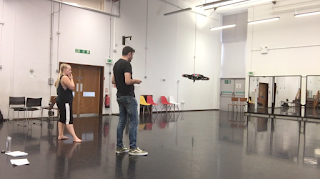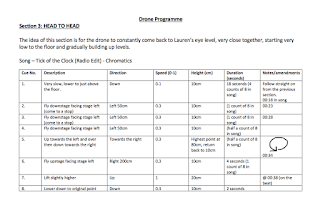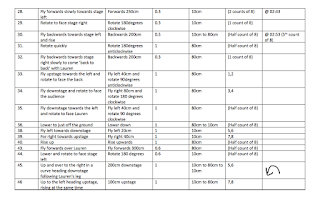After last weeks unexpected turn of events, I was looking forward to meeting with Andrew to finally make some headway of my piece, however, unfortunately he had to cancel. Nevertheless I came into the studio with fresh thoughts on interacting with the drone.
I set myself the task of refusing to use anything but my body and its movements to control the drone. I started slow and at first this seemed fine and this began to seem like a possible beginning to my piece. However, it's become more and more apparent that the only way to interact with the drone, is very slowly, but watching this slow interaction for 30 minutes I imagine must become very tedious for an audience member. And even if I try to move quicker, as soon as the drone starts to go off course its almost impossible to get it to come back and the more frustrated I became, the harder the drone is to control.
The drone never reacts in the same way, or sometimes it doesn't react to me at all, like it chooses when it wants to acknowledge me. I'm beginning to see the drone as a petulant child, always unpredictable and you have to teach it the correct behaviour. Whether the drone is capable of learning however, I am yet to find out.
Within this interaction between the drone and I, referring back to Ben Spatz's method of documentation, I become the Practitioner and the drone is the Director, as the drone is the one providing ideas of movement, by reacting to my presence beneath it. As the Practitioner, I chose whether to follow or disregard the drone's ideas, but almost always found myself following the drone as it is very stubborn and will not accept any suggestions apart from its own. And so despite the fact I am moving my hand underneath the drone and controlling it using my body, the drone's reactions are never the same, so who is the one in control and who is reacting to whom becomes quite blurred. Its almost as though the drone and I are fighting for control of one another, yet in a slow and deliberated quality of movement.
Battery life is also become extremely frustrating. As soon as the drone and I build up a sort of movement pattern and our connection is there, the battery dies. Leaving me then unable to carry on interacting. I'm still yet to decide on how to incorporate this in to the final piece, I was hoping I wouldn't have to, however the more I use the drone, the quicker the batteries wear out. I'm going to have to include one of two battery changes in to performance, yet the trouble is making this appear seamless without disrupting the flow of the piece for the audience.





